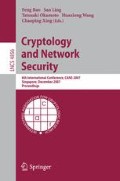Abstract
In this paper we study Perfectly Secure Message Transmission (PSMT) between a sender S and a receiver R, connected in a directed synchronous network through multiple parallel edges (called wires), each of which are directed from S to R or vice-versa. The unreliability of the network is modeled by a Byzantine adversary with infinite computing power. We investigate the problem with two different adversarial settings: (i) threshold and (ii) non-threshold. In [1], the authors have characterized PSMT against a t-active threshold adversary in directed networks. However, their PSMT protocol was exponential both in terms of number of phases and communication complexity. In addition, they also presented a polynomial phase PSMT protocol with n′ = max(3t − u + 1, 2t + 1) wires from S to R. In this paper, we significantly improve the exponential phase protocol and present an elegant and efficient three phase PSMT protocol with polynomial communication complexity (and computational complexity) with n = max (3t − 2u + 1, 2t + 1) wires from S to R. Also with n′ = max (3t − u + 1, 2t + 1) wires from S to R, we are able to further improve the communication complexity of our three phase PSMT protocol. Our second contribution in this paper is the first ever characterization for any two phase PSMT protocol. Finally, we also characterize PSMT protocol in directed networks tolerating non-threshold adversary. In [3], the authors have given the characterization for PSMT against non-threshold adversary. However, in their characterization, they have only considered the paths from S to R, excluding the feedback paths (i.e paths from R to S) and hence their characterization holds good only for single phase protocols. We characterize multiphase PSMT considering feedback paths.
A brief version of this paper appeared in [7] which permits full expanded version to appear elsewhere.
Access this chapter
Tax calculation will be finalised at checkout
Purchases are for personal use only
Preview
Unable to display preview. Download preview PDF.
References
Desmedt, Y., Wang, Y.: Perfectly secure message transmission revisited. Cryptology ePrint Archive, Report 2002/128 (2002), http://eprint.iacr.org
Desmedt, Y., Wang, Y.: Perfectly secure message transmission revisited. In: Knudsen, L.R. (ed.) EUROCRYPT 2002. LNCS, vol. 2332, pp. 502–517. Springer, Heidelberg (2002)
Desmedt, Y., Wang, Y., Burmester, M.: A complete characterization of tolerable adversary structures for secure point-to-point transmissions without feedback. In: Deng, X., Du, D.-Z. (eds.) ISAAC 2005. LNCS, vol. 3827, pp. 277–287. Springer, Heidelberg (2005)
Dolev, D., Dwork, C., Waarts, O., Yung, M.: Perfectly secure message transmission. JACM 40(1), 17–47 (1993)
Kumar, M.V.N.A., Goundan, P.R., Srinathan, K., Pandu Rangan, C.: On perfectly secure communication over arbitrary networks. In: Proc. of 21st PODC, pp. 193–202. ACM Press, New York (2002)
MacWilliams, F.J., Sloane, N.J.A.: The Theory of Error Correcting Codes. North-Holland Publishing Company (1978)
Patra, A., Choudhary, A., Pandu Rangan, C.: Brief announcement: Constant phase efficient protocols for secure message transmission in directed networks. In: Proc of ACM PODC, pp. 322–323 (2007)
Sayeed, H., Abu-Amara, H.: Efficient perfectly secure message transmission in synchronous networks. Information and Computation 126(1), 53–61 (1996)
Shamir, A.: How to share a secret. Communications of the ACM 22(11), 612–613 (1979)
Srinathan, K., Narayanan, A., Pandu Rangan, C.: Optimal perfectly secure message transmission. In: Franklin, M. (ed.) CRYPTO 2004. LNCS, vol. 3152, pp. 545–561. Springer, Heidelberg (2004)
Srinathan, K., Pandu Rangan, C.: Possibility and complexity of probabilistic reliable communication in directed networks. In: Proc. of 25th PODC, pp. 265–274. ACM Press, New York (2006)
Author information
Authors and Affiliations
Editor information
Rights and permissions
Copyright information
© 2007 Springer-Verlag Berlin Heidelberg
About this paper
Cite this paper
Patra, A., Shankar, B., Choudhary, A., Srinathan, K., Rangan, C.P. (2007). Perfectly Secure Message Transmission in Directed Networks Tolerating Threshold and Non Threshold Adversary. In: Bao, F., Ling, S., Okamoto, T., Wang, H., Xing, C. (eds) Cryptology and Network Security. CANS 2007. Lecture Notes in Computer Science, vol 4856. Springer, Berlin, Heidelberg. https://doi.org/10.1007/978-3-540-76969-9_6
Download citation
DOI: https://doi.org/10.1007/978-3-540-76969-9_6
Publisher Name: Springer, Berlin, Heidelberg
Print ISBN: 978-3-540-76968-2
Online ISBN: 978-3-540-76969-9
eBook Packages: Computer ScienceComputer Science (R0)

